Potato harvesting can be quick, slow or even risk injury to the tubers! The way that works best for you depends on the type of garden you have, how big it is, how fast you want to knock it out, and yes, whether or not you want every single potato like me.
Here are five different methods you can use to harvest potatoes, including how I personally do it in my raised beds and what works for containers and row gardening. Stick around for the last method, which actually leaves the plant alive to continue to grow more potatoes!
Before we get started, if you haven’t watched our video or read our blog post on when to harvest potatoes, go check that out. That topic is way more complicated than you’d think—there’s actually 6 different times you might want to pick your potatoes!
If the time is right to harvest, try one of these tried and true methods to retrieve your tubers.
1. Pulling Potatoes
The pulling method of harvesting potatoes works best with containers, raised beds and smaller gardens since it’s a little more labor intensive.
One of the signs that potatoes are ready to harvest is dead or dying yellow and brown stems and leaves, so, one of the easiest and fool-proof methods is to simply pull these plants up by their stem when you spot them. You’ll be beautifying your garden and harvesting all at once!
With each plant you pull, pick off the tubers attached to the roots. I store the potatoes in my handy Roo apron as I go along—that thing can hold a lot of potatoes! It actually gets too heavy for me to hold long before I run out of room in it.
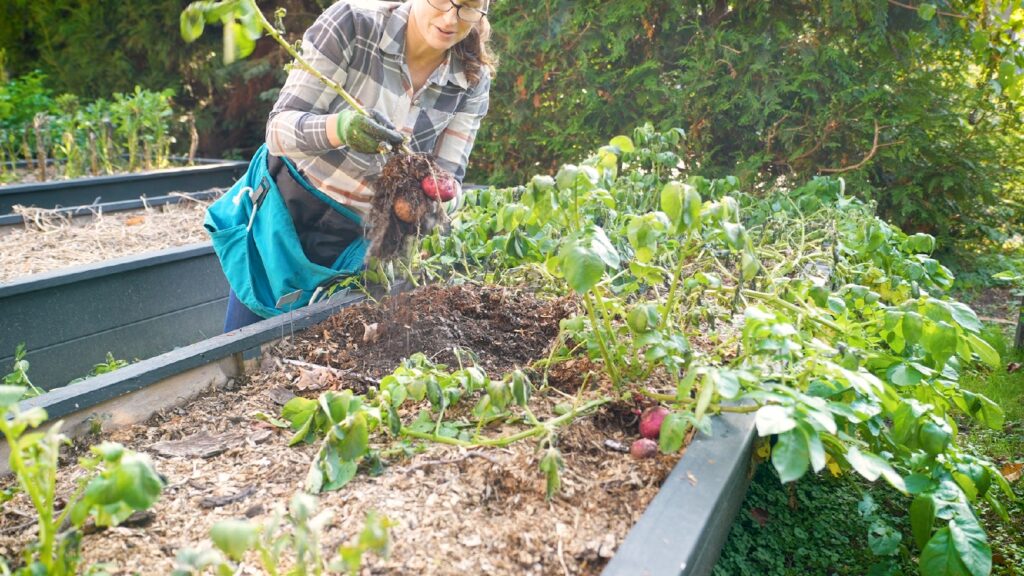
Make sure to compost the spent leaves and stems safely. They’re great for improving soil health, but potato leaves and stems are toxic to humans, livestock, and chickens, so make sure they are out of reach of your children and animals.
2. Digging Potatoes
One of the most popular and fastest ways of harvesting potatoes is digging with a garden fork or shovel. If you’re set up with a wheelbarrow to capture the harvest, you can really cover a lot of ground with the digging method, so this is perfect for large gardens.
I do use the digging method, but only after I’ve pulled the majority of the plants first. Once the bed is fairly clean, I pull out my digging fork. My favorite is this super duty one from Spear & Jackson since it has a long handle. I do not mess around with crappy tools, and long handles mean less bending, especially for taller people! Dig in and use the fork as a sifter to shake all the dirt off the potatoes.
Sometimes I will accidentally stab or slice a potato with this method, making them impossible to store. But because the bed is mostly empty at this point, the odds are lower. If you do injure some tubers, just separate those out and eat those ASAP.
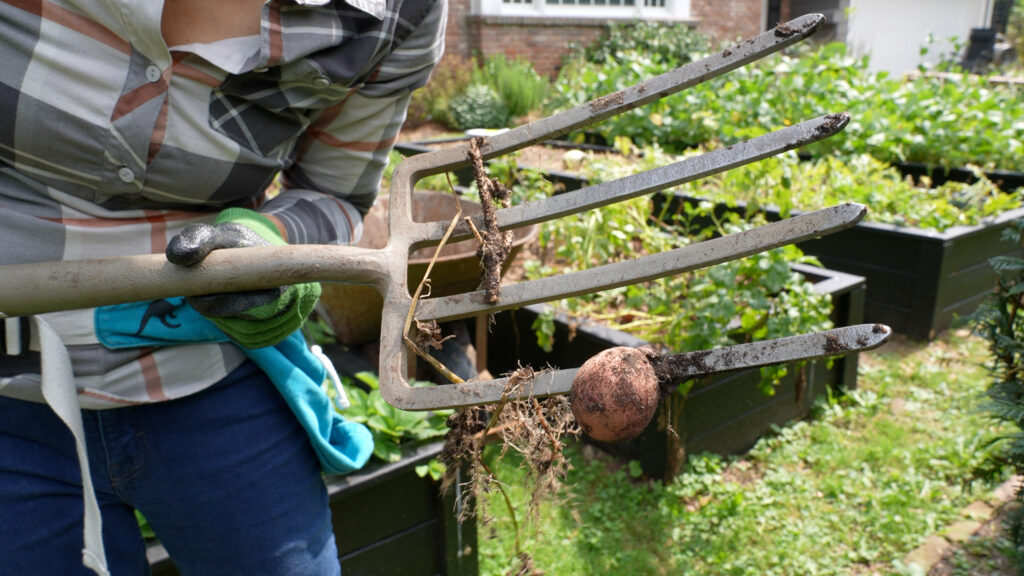
The risk of damaging the potatoes is really the big downside of this method, but if you garden in rows and not raised beds or containers, you can avoid this problem by lifting the potato plants from the side of the hills instead of digging directly overhead.
3. Picking Potatoes By Hand
Harvesting by hand is not for the faint of heart! It does take more time than the pulling and digging methods. But, it still has its place in the busy home garden. It’s perfect for gardeners with container potatoes, people who have very loose soil, and people—like me—who want every single last potato out of their beds.
Why? Because, mashed potatoes?
You guys, leave a comment below if there is actually a word for this technique, but this is my word—scruffling.
So, after I’ve pulled and dug up 99% of the potatoes out of the bed, I come through and just scratch around in the soil with my hands. Just feel around for potatoes. Usually what I find are the tiny tastiest new potatoes that fell off the roots in the pulling stage, and fell between the tines of the garden fork in the digging stage.
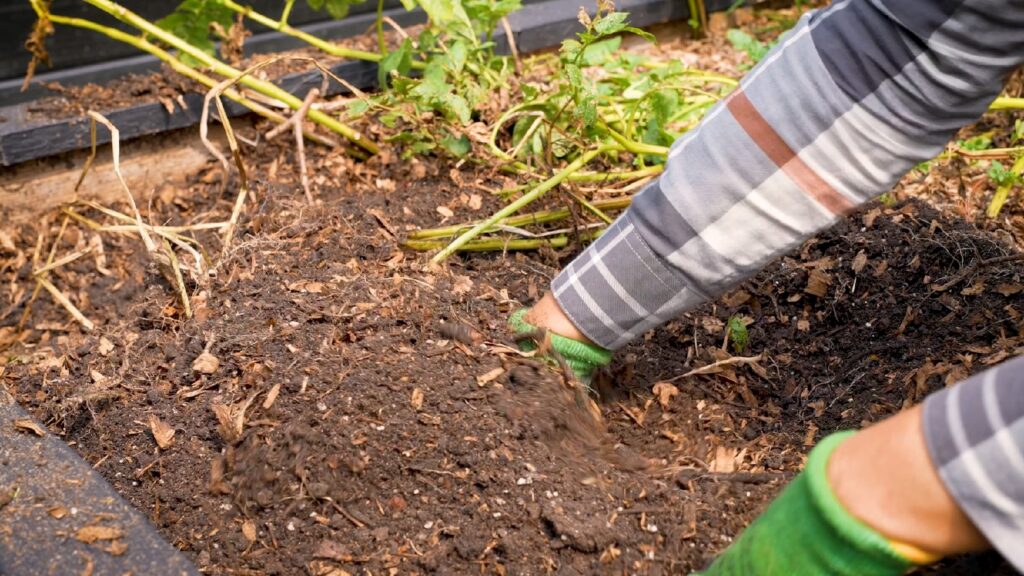
I have big beds—14 by 3 feet—but this method takes me less than 5 minutes to go over the whole bed and is completely worth it in my opinion.
4. Dumping Container Potatoes
If you have containers or grow bags, another easy method for harvesting potatoes is by dumping. I’ve never grown potatoes in containers, but I’ve grown sweet potatoes this way.
There’s pros and cons here to simply dumping the potatoes, soil and all, out of the container. It sounds simple, and it is, so that’s a pro. Also a plus, you won’t need to do any “scruffling”. You will get every single potato without any additional digging around.
The downside is, and don’t laugh at me for not realizing this initially, but, you have to put all the soil back in! Even if you plan ahead by putting a tarp down to catch all the soil, it might be too heavy to just pour back in with the tarp. You’ll be shoveling all that soil back for only a few potatoes. I have tried the dumping method to harvest sweet potatoes, and decided the pull-scruffle combo was less work.
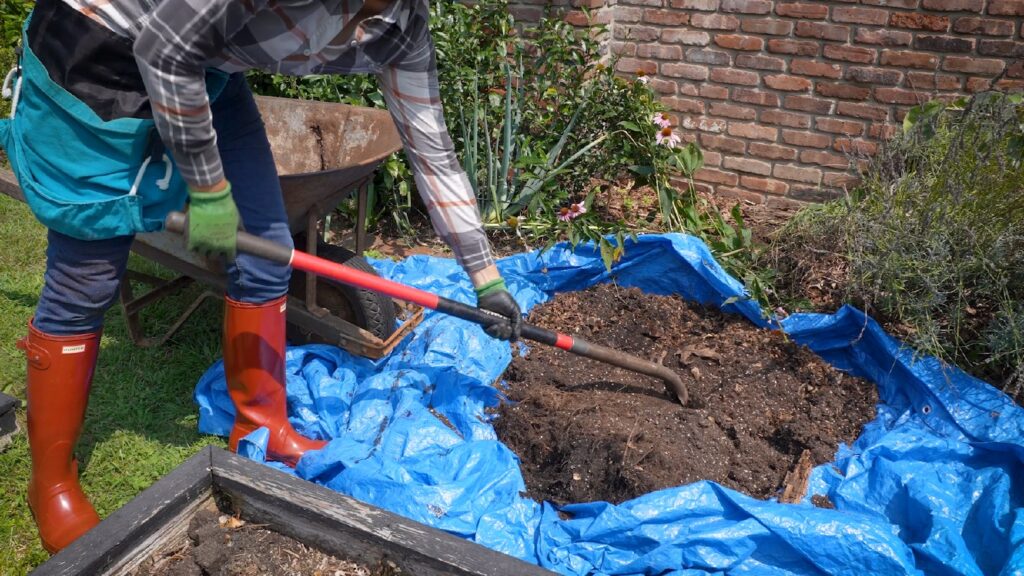
5. Harvest Potatoes Without Killing the Plant
The last method is one of my favorites. If you do this right, you can harvest new potatoes in the spring, but still keep the plant alive for your big potato harvest later in the summer.
Make sure to wait a minimum of 6-7 weeks after you’ve planted for this method. Some varieties and climates allow potato plants to flower. If you do get flowers, wait until they’ve all dropped and then that’s a good sign the new potatoes are ready. You can also use this method anytime after that, when you want just a few potatoes for dinner, but you’re not ready yet to do a full harvest.
To start, find the plant you want to harvest from. I usually pick one on the outside edge of my raised bed to minimize damage to other plants. You’ll want to use your bare hands or some extremely sensitive garden gloves so you can feel the potatoes. Don’t use a tool like a trowel or a hori hori or you’re just gonna cause a lot of damage.
Dig with one hand off to the side of the plant. Just don’t disturb the initial potato you planted as seed, the “mother tuber” which is directly below the stem.
Ladies—and the highly intelligent bros out there with man bags!—this is exactly like digging around in a bottomless purse for your lip balm. It’s 100% by touch and you better know exactly what a dirty potato feels like!
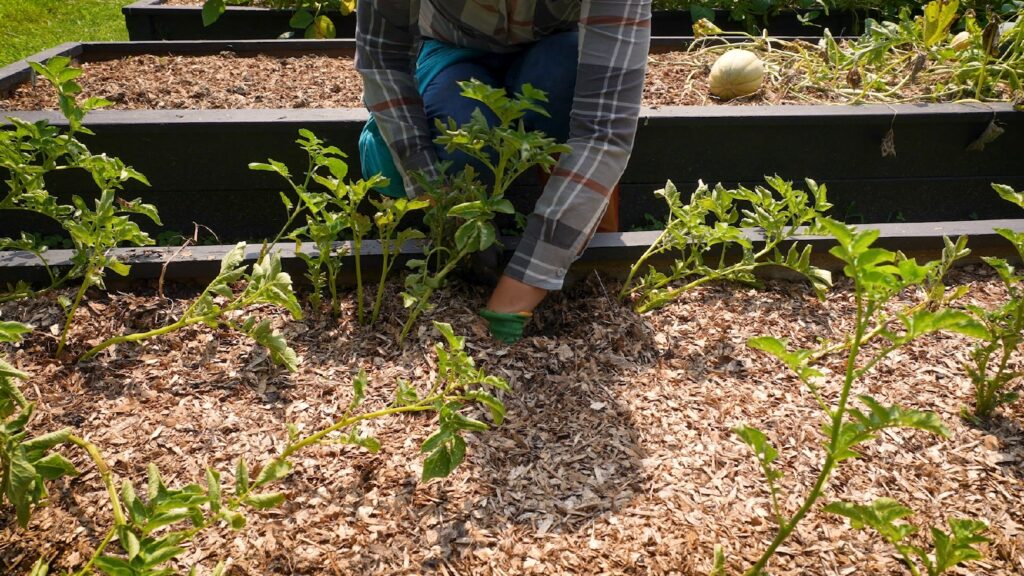
To Recap
Everyone can harvest with this last method anytime between the new potato phase and the final harvest. For the main harvest, large gardens and in-ground row gardens, I would say use digging, maybe pulling. Raised bed gardeners, like me, use a combo of pulling, then digging if your beds are big. Containers, use the pulling method, not dumping. And everyone, everyone should scruffle!
What’s your favorite way to capture your potato harvest? Do you use a combination of methods like me? Let us know in the comments what your potato harvesting routine is!!
Sources
- Illinois Grazing Manual Fact Sheet: Potato, US Department of Agriculture
- Growing Potatoes in a Home Garden, University of Maryland


Leave a Reply